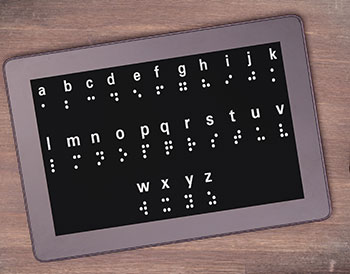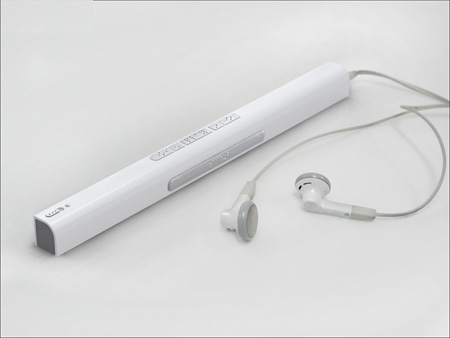Wearable Technology for Low Vision: Making Everyday Tasks Easier
Wearable Technology for Low Vision: Making Everyday Tasks Easier
Blog Article
Empowering Self-reliance With Assistive Innovation for the Blind
The combination of assistive technology into the lives of individuals with aesthetic problems represents a substantial development in advertising independence and self-sufficiency. From innovative screen readers to advanced clever walking canes, these tools not just enhance day-to-day navigating and interaction but likewise equip individuals to involve meaningfully in numerous elements of life. As we explore the myriad benefits and real-world applications of these technologies, it comes to be critical to check out the hidden elements that add to their performance and the potential for future growths in this essential area.
Review of Assistive Technology

The advancement of assistive technology is grounded in principles of inclusivity and empowerment. Advancements in software, equipment, and sensory improvements offer users with alternatives customized to their certain needs. From display viewers that transform text to speech, to tactile devices that convey information via touch, these devices change the method individuals involve with their surroundings.
Along with functional applications, assistive innovation cultivates better social incorporation and involvement in different sectors, consisting of education and work (OCR devices for the blind). As research study and development remain to evolve, the capacity for assistive innovation to additionally boost the lives of visually impaired individuals stays appealing, leading the way for a much more equitable society where everyone can grow
Kinds of Assistive Instruments
A selection of assistive gadgets have actually arised to support individuals with aesthetic problems, each designed to meet certain demands and improve daily performance. These tools range from low-tech options to state-of-the-art technologies, giving varied alternatives for customers.
Low-tech tools include magnifiers and large-print products that aid in analysis and writing. Braille tools, such as Braille slates and styluses, make it possible for responsive analysis and communication. Alignment and wheelchair aids, like white walking canes, aid individuals browse their environment safely.
On the higher end of the spectrum, digital magnification systems and display visitors provide substantial assistance. Electronic magnifiers allow users to expand message and images on screens, while screen viewers convert electronic web content right into synthesized speech, facilitating access to information on smartphones and computers.
Smartphone applications also play an important duty, providing functions like message recognition and navigation help. Wearable technology, such as clever glasses furnished with enhanced fact, is emerging as a promising tool to enhance situational recognition.
Advantages of Assistive Technology
The assimilation of assistive modern technology significantly enhances the lifestyle for individuals with aesthetic problems. These modern technologies encourage individuals by promoting self-reliance, enabling them to navigate their atmospheres much more properly and additional reading do daily tasks with better convenience. For instance, display readers and magnification software permit individuals to gain access to electronic information, promoting specialist and academic chances that may have formerly run out reach.
Moreover, assistive gadgets such as clever walking canes and general practitioners applications offer real-time navigating aid, improving mobility and security. This boosted autonomy not just boosts self-confidence however additionally motivates social engagement, permitting customers to take part even more completely in their communities.
Assistive innovation additionally assists in communication, assisting customers attach with others with voice acknowledgment and text-to-speech applications. This capability is important for preserving partnerships and accessing vital details.
In addition, the modification options available with several assistive modern technologies make certain that individuals can tailor tools to their specific needs, additionally boosting functionality and effectiveness. On the whole, the benefits of assistive technology for people with visual disabilities are extensive, promoting a much more inclusive culture where everyone can pursue their desires and objectives.
Situation Researches and Success Stories
Highlighting the transformative effect of assistive innovation, various case researches illustrate just how individuals with visual disabilities have actually effectively integrated these devices into their daily lives. One engaging instance involves an university trainee who utilized screen analysis software application to navigate academic products and on-line sources properly. This innovation not just facilitated her education and learning yet also enhanced her self-confidence in joining conversations and group jobs.
One more study features a professional who utilizes a smartphone application designed for navigation and temporary double vision object recognition. By using this application, he has regained freedom in both his personal and job settings, enabling him to commute independently and involve with associates better.
In addition, a retired person shared her experience with braille e-readers, which allowed her to access a vast selection of literature and remain gotten in touch with her community with publication clubs.
These success stories highlight the critical duty of assistive modern technology in cultivating freedom, enhancing quality of life, and advertising social assimilation for individuals with visual problems (Braille displays and notetakers). By embracing these ingenious tools, users can get over obstacles and seize opportunities that add to their individual and professional satisfaction

Future Patterns in Assistive Modern Technology
Development in assistive modern technology is poised to redefine the landscape of assistance for people with aesthetic disabilities. Arising fads emphasize the combination of artificial knowledge (AI) and maker understanding, which boost the performance of tools that aid check my source with navigating and details ease of access. As an example, AI-driven applications are now qualified of translating visual information in real-time, allowing individuals to involve with their atmosphere much more individually.
Additionally, the advancement of wearable technology is progressing swiftly. Smart glasses geared up with increased truth (AR) can supply audio descriptions of environments, changing just how customers connect with public areas. These devices not only promote autonomy however additionally foster social inclusion.
In Addition, the Internet of Points (IoT) is making homes smarter, permitting seamless connectivity between assistive devices and day-to-day home appliances. This connectivity encourages users by enabling voice-activated controls and automatic actions customized to private demands.
Verdict
To conclude, assistive innovation plays a critical duty in equipping people with aesthetic impairments by improving their self-reliance and involvement with their surroundings. The varied variety of gadgets and applications available not only promotes navigation and communication yet also promotes social combination and possibilities for expert and personal development. As advancements continue in this field, the capacity for enhancing the top quality of life for those with aesthetic problems will certainly expand, cultivating higher autonomy and empowerment.

Report this page